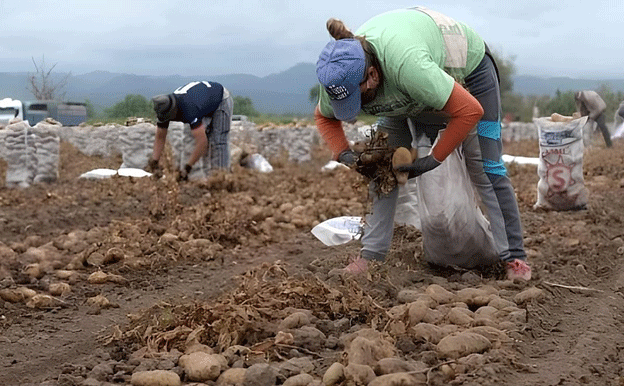The Argentine potato market is currently experiencing a dramatic price drop, with the price of potatoes from Tucumán nearly halving due to an overwhelming oversupply in the country’s fresh produce markets. After a period of climatic normalization that followed weeks of rain, the potato harvest surged, flooding key markets like the Mercado Central de Buenos Aires (MCBA) with unprecedented volumes of potatoes.
The Price Surge and Collapse
In early October, farmers in Argentina experienced a brief spike in potato prices, driven by weather-related disruptions. The persistent rains in Tucumán caused delays in the harvest, pushing prices up to a peak of ARS 15,000 (USD 43) per 20 kg bag of potatoes in the MCBA. However, as weather conditions improved, potato shipments from the region resumed, resulting in a swift and significant increase in market supply.
This surge led to a complete reversal in pricing dynamics. Potato prices fell to ARS 8,000 (USD 23) per 20 kg bag, with some fields in Tucumán seeing prices as low as ARS 6,000 (USD 17) per bag—a decline of nearly 50%. These numbers represent a stark contrast to the average prices observed in recent years, where supply-demand balances were more favorable for farmers.
The Role of Oversupply
The oversupply in the market was largely driven by the arrival of the “early” potato crop, mainly from Tucumán and to a lesser extent from Jujuy. The combination of a quick recovery in the fields post-rain and the high volume of potatoes available for harvest led to a record-breaking influx of stock at the MCBA, which saw 25,000 bags of potatoes—far surpassing the typical seasonal average.
This situation highlights a classic case of supply outstripping demand. Alongside increased shipments, there was a short-term reduction in potato consumption, exacerbating the market imbalance. This brief dip in demand was likely due to the price hike caused by the weather-related disruptions, leaving consumers hesitant to purchase at higher prices.
Impact on Farmers
The drop in prices is a significant concern for farmers, particularly those in Tucumán, who face challenges covering production costs at these lower price points. According to recent agricultural reports, farmers in the region had anticipated stronger market conditions following the rain-induced price surge, only to be confronted with a steep decline due to oversupply.
Additionally, the recent heatwave in northern Argentina is likely to degrade the quality of potatoes that remain unsold in markets. Lower-grade potatoes are already being sold at a discount, and if temperatures remain high, it is expected that prices may continue to decline, especially for inferior potato segments.
What’s Next?
Moving forward, many farmers and market analysts are closely watching how the climate and market conditions evolve. With oversupply and potential quality issues from the heat, it’s uncertain when prices will stabilize. The continued decline in prices could force some farmers to sell their crops at a loss, highlighting the need for better forecasting tools and market diversification strategies to mitigate the impacts of such sharp price fluctuations.
The sharp drop in potato prices in Argentina serves as a reminder of the volatility in agricultural markets, where weather conditions and supply-demand imbalances can drastically affect profitability. For farmers in regions like Tucumán, oversupply, coupled with heat-induced quality degradation, is creating an economic challenge. To navigate these challenges, improving market forecasting, investing in storage solutions, and diversifying crop production could offer more stability in the face of unpredictable market dynamics.

